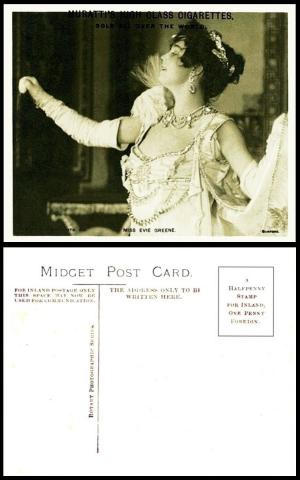
This is included because if you do not look closely at the front of the card you may just think it is a Rotary postcard and nothing to do with cartophily. However, it will also show you not to be so hasty in future when you see bundles of postcards similar to this.
This is one of a complex group, which first appears in the original London Cigarette Card Company Handbook, of 1950, described as :
H.286. MIDGET POSTCARD SERIES (titled series). Large cards. Fronts photoprints. Issued by Muratti. Inscribed "Rotary Photo. E.C.", preceded by four or five figure reference number, otherwise unnumbered. Back in post-card format. Inscribed on front "Muratti`s High Class Cigarettes - Sold All Over the World". Selected subjects from a very extensive range of small sized post-cards in vogue about 1905. Size approx 90 x 70 mm.
1. Matt front, in black/sepia. 12 subjects seen
1. 7567 Collie Puppies
2. 6201 King Edward VII
3. 7560 Me and Mine
4. 680211 Sybil Arundale
5. 6826 Miss Cecile Engleheart
6. 6831 Miss Louie Freear
7. 6834 Miss Evie Green
8. 6849.B Miss Edna May
9. 6865.B Miss Marie Studholme
10. 7566 Skye Terriers
11. 7565 The Doorkeeper
12. 7554 What are You ?
Now this is followed by section II but they are glossy "English Views", plus a section of cards with reference numbers that begin "41", and other cards which have no reference numbers, but presumably mention Muratti or they would not be here. I imagine we will get around to including them one day too. By the way, the "X" reference only applies to section ii, it i the finding of another card, of Broadstairs.
In our World Tobacco Issues Index, this is shorter, and so I can include all the groups, for reference - and I do mean "all" for there is a further group I had not even noticed in the above book. This reads :
MIDGET POST CARD SERIES (A). Lg. See H.286, Ha. 286 and X1/H.286. ... M160-11
I. Matt front. Size about 90 x 70. Muratti`s name in black. Miscellaneous subjects. 12 known.
II. Glossy Front. Size about 85 x 65. Muratti`s name in red.
(i) Reference numbers commencing "40". English views, with captions. 54 known
(ii) Reference numbers commencing "41". Miscellaneous subjects with captions. 6 known
(iii) Without reference numbers. Views without captions. About 30 seen.QUEEN`S POST CARD SERIES. Lg. about 90 x 70. Muratti`s name in black. Matt photos. 36 known. See H.287 ... M160-12
A. Front in black-sepia
B. Front in reddish-brown
Now this is somewhat enlarged in our updated World Tobacco Issues Index, to :
MIDGET POST CARD SERIES (A). Lg. See H.286 ... M958-130
I. Matt front. Black photos.
(i) Size about 90 x 70. Muratti`s name in black. Miscellaneous subjects. Reference numbers between 6201 and 7567. (99 known, probably about 160 issued)
(ii) Size about 85 x 65. Muratti`s name in red. Actors and Actresses, no captions or reference numbers. (5 known)
II. Glossy front, sepia photos. Size about 85 x 65, few 75-80 x 65. Muratti`s name in red.
(i) With reference numbers and captions. (136 known)
(ii) Without reference numbers and captions. (76 known)QUEEN`S POST CARD SERIES. Lg. about 90 x 70. Muratti`s name in black. (99 known). See H.287 ... M958-150
A. Back inscribed "Queen`s Post Card", with divisions for address and communication. Front in (a) black (b) reddish-brown
B. Back inscribed "Post Card" and "Queen`s Series" at side, with space for address only. Front in black, with picture as in A., but shortened to allow space for communication.
Now postcard collector readers will know already that these last two sections are the wrong way round. This is because at one time you could only write the address on the back of a postcard not any message. This was squeezed into any space that could be found on the front. However, the British Post Office changed this, in 1902, and allowed for messages to appear on the same side as the address. This got a bit messy, so postcard companies started to print their cards with a dividing line in the middle, and then, a bit later, added headings to each section so it was less easy to confuse which was for the message and which for the address. This also came into effect in America, but not until 1907.
Therefore the postcards in B were not "shortened to allow space for communication", they were just issued with a space that was utilised, for a very brief message, by the writer. Postcards were still issued with spaces around them, or to one side, after the arrival of the divided back, and some writer still pressed them into service, for a postscript, or, curiously, a message whilst one side of the reverse was left blank.
